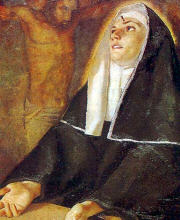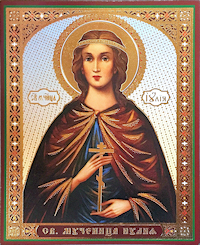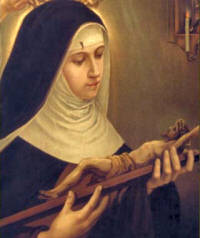Ordinary Time: May 22nd
Optional Memorial of Saint Rita of Cascia, religious
Other Commemorations: St. Julia of Corsica, Virgin and Martyr (RM) ; Other Titles: Margarita of Cascia; Rita La Abogada de Imposibles
» Enjoy our Liturgical Seasons series of e-books!
After eighteen years of married life, St. Rita lost, by death, her husband and her two sons. Called afterwards to the religious state, she professed the Rule of St. Augustine at Cascia her native town, in central Italy. In a life-long and terrible malady her patience, cheerfulness, and union by prayer with almighty God, never failed her. Jesus imprinted on her brow the mark of a thorn from His crown. She died May 22, 1456, and both in life and after death has worked many miracles. This optional memorial is new to the USA liturgical calendar.
St. Rita of Cassia
Rita's childhood was one of happiness to her parents. To satisfy her desire of a life of union with God by prayer, her parents fitted up a little room in their home as an oratory, where she spent all her spare moments. At the age of twelve, however, she desired to consecrate herself to God in the religious state. Pious though her parents were, their tearful pleadings to postpone her noble purpose prevailed on Rita, and they gave her in marriage, at the age of eighteen, to an impulsive, irascible young man, who was well fitted to try the patience and virtue of the holy girl. Two sons were born to them, each inheriting their father's quarrelsome temperament. Rita continued her accustomed devotions, and her sanctity and prayers finally won her husband's heart so that he willingly consented that she continue her acts of devotion.
Eighteen years had elapsed since her marriage, when her husband was murdered by an old enemy; both of her sons died shortly after. Rita's former desire to consecrate herself to God again took possession of her. Three times she sought admittance among the Augustinian Nuns in Cascia, but her request was refused each time, and she returned to her home in Rocca Porrena. God Himself, however, supported her cause. One night as Rita was praying earnestly in her humble home she heard herself called by name, while someone knocked at the door. In a miraculous way she was conducted to the monastic enclosure, no entrance having been opened. Astonished at the miracle, the Nuns received Rita, and soon enrolled her among their number.
 St. Rita's hidden, simple life in religion was distinguished by obedience and charity; she performed many extreme penances. After hearing a sermon on the Passion of Christ she returned to her cell; kneeling before her crucifix, she implored: "Let me, my Jesus share in Thy suffering, at least of one of Thy thorns". Her prayer was answered. Suddenly one of the thorns detached and fastened itself in her forehead so deeply that she could not remove it. The wound became worse, and gangrene set in. Because of the foul odor emanating from the wound, she was denied the companionship of the other Sisters, and this for fifteen years.
St. Rita's hidden, simple life in religion was distinguished by obedience and charity; she performed many extreme penances. After hearing a sermon on the Passion of Christ she returned to her cell; kneeling before her crucifix, she implored: "Let me, my Jesus share in Thy suffering, at least of one of Thy thorns". Her prayer was answered. Suddenly one of the thorns detached and fastened itself in her forehead so deeply that she could not remove it. The wound became worse, and gangrene set in. Because of the foul odor emanating from the wound, she was denied the companionship of the other Sisters, and this for fifteen years.
Miraculous power was soon recognized in Rita. When Pope Nicholas IV proclaimed a jubilee at Rome, Rita desired to attend. Permission was granted on condition that her wound would be healed. This came about only for the duration of the trip. Upon her return to the monastery the wound from the thorn reappeared, and remained until her death.
As St. Rita was dying, she requested a relative to bring her a rose from her old home at Rocca Porrena. Although it was not the season for roses, the relative went and found a rose in full bloom. For this reason roses are blessed in the Saint's honor.
After St. Rita's death, in 1457, her face became beautifully radiant, while the odor from her wound was as fragrant as that of the roses she loved so much. The sweet odor spread through the convent and into the church, where it has continued ever since. Her body has remained incorrupt to this day; the face is beautiful and well preserved.
When St. Rita died the lowly cell was aglow with heavenly light, while the great bell of the monastery rang of itself. A relative with a paralyzed arm, upon touching the sacred remains, was cured. A carpenter, who had known the Saint, offered to make the coffin. Immediately he recovered the use of his long stiffened hands.
As one of the solemn acts of his jubilee, Pope Leo XIII canonized St. Rita on the Feast of the Ascension, May 24, 1900.
—Excerpted from Heavenly Friends, Rosalie Marie Levy
Patronage: Abuse victims; against loneliness; against sterility; bodily ills; desperate causes; difficult marriages; forgotten causes; impossible causes; infertility; lost causes; parenthood; sick people; sickness; sterility; victims of physical spouse abuse; widows; wounds.
Symbols and Representation: Nun holding a crown of thorns; nun holding roses; nun holding roses and figs; nun with a wound on her forehead
Highlights and Things to Do:
- From the Catholic Culture library:
- Read more about St. Rita:
- Visit the National Shrine of St. Rita of Cassia and read this life of St. Rita.
- Watch these videos of St. Rita's life here and here.
St. Julia of Corsica
St. Julia was a noble virgin of Carthage, who, when the city was taken by Genseric in 489, was sold for a slave to a pagan merchant of Syria named Eusebius. Under the most mortifying employments of her station, by cheerfulness and patience she found a happiness and comfort which the world could not have afforded.
All the time she was not employed in her master's business was devoted to prayer and reading books of piety. Her master, who was charmed with her fidelity and other virtues, carried her with him on one of his voyages to Gaul. Having reached the northern part of Corsica, he cast anchor, and went on shore to join the pagans of the place in an idolatrous festival. Julia was left at some distance, because she would not be defiled by the superstitious ceremonies which she openly reviled.
 Felix, the governor of the island, who was a bigoted pagan, asked who this woman was who dared to insult the gods. Eusebius informed him that she was a Christian, and that all his authority over her was too weak to prevail with her to renounce her religion, but that he found her so diligent and faithful he could not part with her. The governor offered him four of his best female slaves in exchange for her. But the merchant replied, "No; all you are worth will not purchase her; for I would freely lose the most valuable thing I have in the world rather than be deprived of her." However, the governor, while Eusebius was drunk and asleep, took upon him to compel her to sacrifice to his gods. He offered to procure her liberty if she would comply. The Saint made answer that she was as free as she desired to be as long as she was allowed to serve Jesus Christ. Felix, thinking himself derided by her undaunted and resolute air, in a transport of rage caused her to be struck on the face, and the hair of head to be torn off, and lastly, ordered her to be hanged on a cross till she expired. Certain monks of the isle of Gorgon carried off her body; but in 768 Desiderius, King of Lombardy, removed her relics to Breseia, where her memory is celebrated with great devotion.
Felix, the governor of the island, who was a bigoted pagan, asked who this woman was who dared to insult the gods. Eusebius informed him that she was a Christian, and that all his authority over her was too weak to prevail with her to renounce her religion, but that he found her so diligent and faithful he could not part with her. The governor offered him four of his best female slaves in exchange for her. But the merchant replied, "No; all you are worth will not purchase her; for I would freely lose the most valuable thing I have in the world rather than be deprived of her." However, the governor, while Eusebius was drunk and asleep, took upon him to compel her to sacrifice to his gods. He offered to procure her liberty if she would comply. The Saint made answer that she was as free as she desired to be as long as she was allowed to serve Jesus Christ. Felix, thinking himself derided by her undaunted and resolute air, in a transport of rage caused her to be struck on the face, and the hair of head to be torn off, and lastly, ordered her to be hanged on a cross till she expired. Certain monks of the isle of Gorgon carried off her body; but in 768 Desiderius, King of Lombardy, removed her relics to Breseia, where her memory is celebrated with great devotion.
St. Julia, whether free or a slave, whether in prosperity or in adversity, was equally fervent and devout. She adored all the sweet designs of Providence; and far from complaining, she never ceased to praise and thank God under all his holy appointments, making them always the means of her virtue and sanctification. God, by an admirable chain of events, raised her by her fidelity to the honor of the saints, and to the dignity of a virgin and martyr.
—Excerpted from Butler's Lives of the Saints
Patronage: torture victims; Corsica, France; Brescia, Italy; Leghorn, Italy; Livorno, Italy; pathologies of the hands and feet
Symbols and Representation: Palm of martyrdom; crucifix
Highlights and Things to Do:






